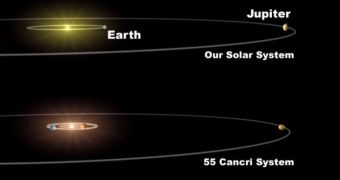The National Ignition Facility (NIF) now boasts a brand new laser facility, designed primarily to assist the military with fusion data related to various experimental information. The “mega-laser” is one of the most powerful on Earth, and only recently have scientists come to see that the device could be used for other applications as well, besides the nuclear fusion. Thus, they will now attempt to use the laser look around the Universe, probing exoplanets in search for readings that are unavailable when looking at the celestial bodies with Earth- or orbit-based telescopes.
The Lawrence Livermore National Laboratory in California hosts the NIF, which has been inaugurated earlier this month. The lasers work in the ultraviolet wavelength, and are able to emit roughly 500 trillion watts in 20-nanosecond bursts. One of the most immediate applications that have become obvious to researchers has been the fact that it's now possible to recreate the conditions inside the cores of large planets such as Jupiter, where pressures can be more than 1,000 times higher than that in Earth's innermost core.
University of California Berkeley (UCB) astronomer Raymond Jeanloz details the procedure associated with these simulations. He says that the laser will be fired at an 800 micrometer-large iron sample, which will most likely be instantly vaporized by the enormous amount of heat the device produces. When this happens, the sample will emit an incredibly strong shock wave, which will compress the entire mix into an even tinier piece of metal, at a pressure about a billion times higher than that of our atmosphere.
Afterwards, research teams will analyze the reshaping of the metal's crystalline structure, and will look for changes in its melting point temperatures. Jeanloz maintains that these readings will offer astronomers a deep insight into how similar elements came together to form massive planets the size of Jupiter and Saturn. “The chemistry of these planets is completely unexplored. It's never been accessible in the laboratory before,” he shares.
The Livermore team also has important applications in mind for the new laser facility. Next year, they will attempt to fire the device at a “ball” of hydrogen isotopes, in hope of creating a self-sustaining nuclear fusion reaction. Throughout the world, there are other science teams that have managed to ignite such reactions, but none of them have been self-sustaining, and quickly died out. Next year's experiment will attempt to trigger a working, sustainable reaction, to go on until the last bit of fuel is consumed. If their research is successful, then the Livermore Laboratory could be the one to offer the basis for the creation of the first commercial nuclear fusion power plants.

 14 DAY TRIAL //
14 DAY TRIAL //